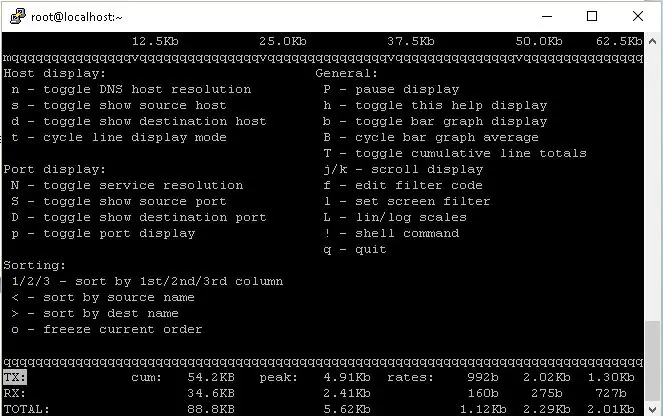http://linuxtechlab.com/monitoring-network-bandwidth-iftop-command
System
Admins are required to monitor IT infrastructure to make sure that
everything is up & running. We have to monitor performance of
hardware i.e memory, hdds & CPUs etc & so does we have to
monitor our network. We need to make sure that our network is not being
over utilised or our applications, websites might not work. In this
tutorial, we are going to learn to use IFTOP utility.
(Recommended read : Resource monitoring using Nagios, Tools for checking system info, Important logs to monitor)
Iftop is network monitoring utility that provides real time real time bandwidth monitoring. Iftop measures total data moving in & out of the individual socket connections i.e. it captures packets moving in and out via network adapter & than sums those up to find the bandwidth being utilized.
$ sudo apt-get install iftop
After epel repository has been installed, we can now install iftop by running,
$ yum install iftop
This will install iftop utility on your system. We will now use it to monitor our network,
$ iftop

You will now be presented with network activity happening on your machine. You can also use
$ iftop –n
Which will present the network information on your screen but with ‘-n’ , you will not be presented with the names related to IP addresses but only ip addresses. This option allows for some bandwidth to be saved, which goes into resolving IP addresses to names.
Now we can also see all the commands that can be used with iftop. Once you have ran iftop, press ‘h’ button on the keyboard to see all the commands that can be used with iftop.

To monitor a particular network interface, we can mention interface with iftop,
$ iftop –I enp0s3
You can check further options that are used with iftop using help, as mentioned above. But these mentioned examples are only what you might to monitor network.
Iftop is network monitoring utility that provides real time real time bandwidth monitoring. Iftop measures total data moving in & out of the individual socket connections i.e. it captures packets moving in and out via network adapter & than sums those up to find the bandwidth being utilized.
Installation on Debian/Ubuntu
Iftop is available with default repositories of Debian/Ubuntu & can be simply installed using the command below,$ sudo apt-get install iftop
Installation on RHEL/Centos using yum
For installing iftop on CentOS or RHEL, we need to enable EPEL repository. To enable repository, run the following on your terminal,RHEL/CentOS 7
$ rpm -Uvh https://dl.fedoraproject.org/pub/epel/7/x86_64/e/epel-release-7-10.noarch.rpmRHEL/CentOS 6 (64 Bit)
$ rpm -Uvh http://download.fedoraproject.org/pub/epel/6/x86_64/epel-release-6-8.noarch.rpmRHEL/CentOS 6 (32 Bit)
$ rpm -Uvh http://dl.fedoraproject.org/pub/epel/6/i386/epel-release-6-8.noarch.rpmAfter epel repository has been installed, we can now install iftop by running,
$ yum install iftop
This will install iftop utility on your system. We will now use it to monitor our network,
Using IFTOP
You can start using iftop by opening your terminal windown & type,$ iftop

You will now be presented with network activity happening on your machine. You can also use
$ iftop –n
Which will present the network information on your screen but with ‘-n’ , you will not be presented with the names related to IP addresses but only ip addresses. This option allows for some bandwidth to be saved, which goes into resolving IP addresses to names.
Now we can also see all the commands that can be used with iftop. Once you have ran iftop, press ‘h’ button on the keyboard to see all the commands that can be used with iftop.

To monitor a particular network interface, we can mention interface with iftop,
$ iftop –I enp0s3
You can check further options that are used with iftop using help, as mentioned above. But these mentioned examples are only what you might to monitor network.

No comments:
Post a Comment